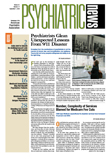Disparities in access to mental health services should be addressed at the public-policy, community, and provider-to-patient levels.
So said Margarita Alegria, Ph.D., a professor of psychology in the Department of Psychiatry at Harvard Medical School, in a presentation on mental health disparities to the APA Board of Trustees in July at a retreat preceding its regular summer meeting (Psychiatric News, August 18). She was invited by APA President Pedro Ruiz, M.D.
Alegria presented data from the pooled National Co-Morbidity Survey Replication (NCS-R) and the National Latino and Asian American Study (NLAAS). The latter is a national psychiatric epidemiologic survey conducted to measure prevalence of psychiatric disorders and mental health service usage in a nationally representative sample of Latinos and Asian Americans.
She also discussed interventions to remedy disparities, including national publicpolicy reforms, changes at the community level focusing on the differential pathways to specialty care affecting minorities, and interventions to improve clinician-patient communication.
Resolving the problem will require working at all three levels. “One level is the failure of health care markets and how they affect both the low-quality options and the choices of providers that people might have,” she said. “The second level is the differential pathway to care that might happen, leaving people with limited access, particularly to specialty treatments. The third level is patient-provider interaction and how that affects differential treatment outcomes that lead to lower functioning, greater burden of illness, and lower quality of life.”
A fundamental problem, Alegria said, is entry into the health care system and the widespread lack of insurance.
“If we really want to change things in terms of access to care and delivery of services to our populations, it's very important to think about health policy and market interventions that could really bring the whole population into a better state of care,” Alegria said.
Disparities in access to services are largely related to lack of insurance, Alegria said. In 2004, 45.8 million people were without health insurance coverage, up from 45 million people in 2003, with no change in the percentage of people without health insurance coverage (15.7 percent) between 2003 and 2004. This lack of insurance especially affects Latino and Asian-American communities. Forty percent of Latinos have no health insurance, and for Latinos who have been in the United States less than five years—and for that reason are eligible for Medicaid—the rate is 58.6 percent.
One solution to this problem is to revise the Personal Responsibility and Work Opportunity Reconciliation Act of 1996, also known as the welfare reform law. That law, Alegria pointed out, restricts states from using federal funds to provide Medicaid and SCHIP coverage for certain groups, shifts health care costs from the federal to state level, and differentially affects ethnic groups depending on citizenship or refugee status.
At the community level, Alegria said addressing differential pathways into care is another target to explore. Such interventions might facilitate access to specialty services through social marketing campaigns and incentives for successful referral and engagement.
Alegria told the Board that the NLAAS found that only one-quarter of the respondents reported ever having been asked by a clinician about alcohol or drug use. Moreover, less than 20 percent reported ever having been asked about emotions, nerves, or mental health problems, she said.
Of those unable to communicate with a primary care provider in their language of choice, fewer than 4 in 10 had interpreter services available, she said.
Finally, a third avenue of intervention might be efforts to improve clinician-patient communication, such as “patient activation” and provider communication trainings. Patient activation refers to the enhancement of involvement of patients in their own health care through teaching health management techniques and problem-solving skills.
Alegria said that about 20 percent of the NLAAS respondents indicated having had a negative experience with service providers. Only 50 percent rated psychiatric treatment as being helpful, and just 57 percent said they completed treatment.
“The question is how we can help patients ask for what they want and get what they need out of mental health care and how we can train providers to be more facilitating and attentive to what patients want,” Alegria said.▪
